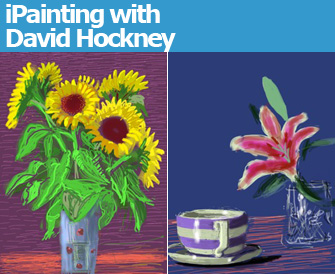
David Hockney’s paintings are so pretty and colorful and joyful that it should be easy to dismiss them as not being serious art. And what could be prettier than the flowers that are the subject of the new show “Fleurs Fraîches” (“Fresh Flowers”) at the Fondation Pierre Bergé-Yves Saint Laurent?
Hockney is a serious artist, however, and always has something extra to offer. This time the surprise is that all these flower pictures were drawn and are displayed on iPhones or iPads. This is not just a gimmick for Hockney, who has always been an early adopter interested in new technologies. In the past he has experimented with printing out computer-generated images and making drawings meant to be faxed. For this exhibition, he simply e-mailed his works to the foundation.
The whole thing started rather accidentally when he was staying in his native Yorkshire and could see the sunrise every morning from his bed. One morning he grabbed his iPhone and started finger-painting on it (he uses mostly the program Brushes). He would send the resulting drawings to his friends, who naturally encouraged him to keep it up. He had no problem drawing on such a small screen, since he was used to carrying a very small sketchpad in his pocket. Later, he migrated to the iPad as soon as it came out and loves it for its higher level of sophistication.
In the exhibition, the drawings made on an iPhone are shown on iPhones, while those made on an iPad are shown on iPads. All are also projected in rotation in a triptych on a large screen. A short film shows Hockney drawing on his iPad in front of the open window of his Paris hotel room.
Each of Hockney’s ipictures is a little gem of luscious, almost Fauvist colors. One can’t help but think of Matisse when looking at them, especially those with a view through an open window. Not all are of flowers; there is one portrait of a friend as well as a few landscapes and even a written manifesto: “Made for the screen. Really on screen. It is not an illusion.”
The stained-glass quality of the backlit images is stunning (the pictures above don’t do them justice). When you go to the exhibition, notice especially the various depictions of the sun, of a burning candle, and of crystal and glass vases. It looks easy but don’t try this yourself at home – you may be disappointed with the results.
Ipainting has an added advantage for Hockney: there is no mess. Old habits die hard, however, and he often finds himself wiping his thumb on his clothes as if wiping off paint.
Some of the iPad displays are animated so that you can see how Hockney constructed the picture. One of my favorites shows a lamp on a desk with a glowing yellow shade, a circle of suffused light falling on the flat surface and a few odd books. While watching the animation, you will see the artistic decisions Hockney made as he worked – how he first blocked out the architecture of the picture and then built up layer after layer and added details, later painting out a book placed close to the lamp and adding a pile of books farther away to better balance the composition. These animations show how much work goes into what looks like a simple drawing.
Apparently no artist has revealed his artistic process in this way since the film The Mystery of Picasso, made in 1956, in which Picasso drew on glass and painted on paper for the camera. And like the works made by Picasso for that film, which were destroyed after the film was made, these works by Hockney have only a virtual existence. They are not made for reproduction and are not for sale (at least not for the moment; “I haven’t figured out a way to be paid for them,” he says). They are distributed only to his friends by e-mail.
Hockney is only to be admired for being his own artist and ignoring trends. His swimming pool series, for example, was painted at a time when abstraction and Pop Art held sway and plain old figurative art was scorned by the art world. He has been criticized for not being avant-garde enough, but he continues to go his own way. His work is deeply appealing, full of lighthearted fun but made with passion and skill.
Don’t miss this show; it will be a bright moment in your day.
Favorite